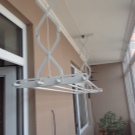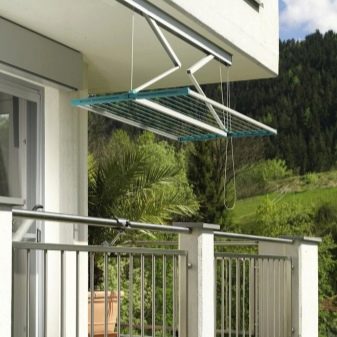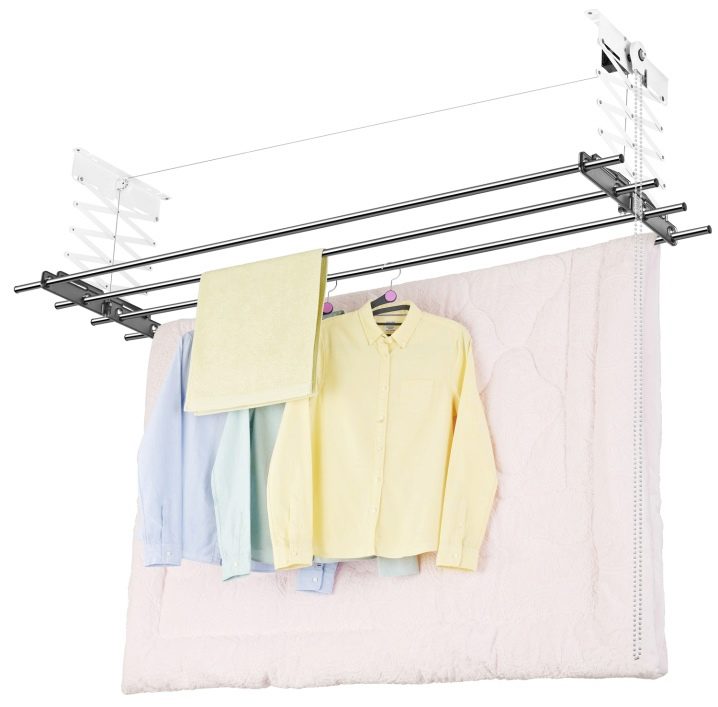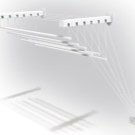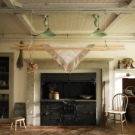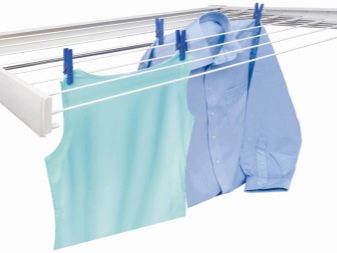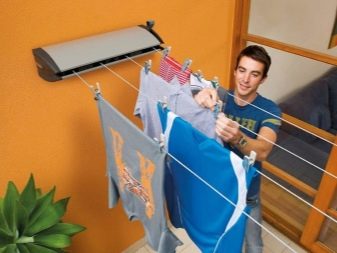Ceiling dryer on the balcony for linen
Drying clothes is an integral part of the household. There are a lot of different ways of drying, but thanks to the invention of all new devices, this process is simplified. Now it is carried out with the help of various types of dryers.
The issue of space occupied by the dryer is acute in terms of space occupied - for example, if you need to dry not only clothes and towels, but a sheet or set, it takes quite a lot - the fixture can take half of the room and even more, which makes the balcony an ideal place for their location .
However, everything is not as simple as it may seem at first glance. As you know, fresh air contributes to quick drying - but this is almost the only thing that simplifies drying. If you just hang the clothes on a regular clothesline, you can get various contaminants on it - small debris, cigarette butts, dust, etc. (if the balcony or the loggia is not glazed).Moreover, it is not very aesthetically pleasing, because the laundry will be put on display.
The solution to this problem was the ceiling dryer on the balcony for laundry. Now it is very popular due to the following advantages:
- Do not interfere with movement;
- Maintain very large loads (up to 30 kg);
- Linen dries faster because the heat rises up (and not vice versa, if the dryer is outdoor);
- Easy installation (easy to install or hang);
- Ability to mount on virtually any surface.
There are a number of various models of ceiling dryers - different in terms of overall dimensions, devices (mechanical or electronic), material of execution (plastic, wood, etc.), installation principle (removable or stationary) and method of attachment (to the floor or to the ceiling). In order to choose the right type of ceiling dryer, it is important to consider the following factors:
- The dimensions of the room where you want to install the dryer;
- The material of the surface to which the dryer will be attached;
- What exactly to dry on it - large \ small things and their material;
- Installation features;
- Components - what is included and not included in the set for the installation of dryers.
Ceiling clothes dryers are of the following types:
- Sliding
- Folding
- Suspended mesh
- Liana
Little ones
The simplest balcony ceiling dryers are small round or square frames of plastic and metal, decorated with hooks around the perimeter. Visually, they resemble chandeliers with glass decorations. Designed for drying small items such as socks, underwear or hand towels. However, they have some drawbacks - it is better not to stop the choice on the dryer made of plastic. Due to the fragile design, they can fall even with a weak wind.
With polymer mesh
The next type is a dryer with a polymer mesh. Thanks to the perforation, the mesh is well breathable, moreover, it is possible to completely decompose the object of drying on it. It is designed for drying heavy things - for example, wool sweaters or blown jackets. Dryers of this kind can have one or several tiers (i.e., polymer grids stretched on a plastic frame). The disadvantage is a plastic hook,which is not the most successful mounting option due to the low strength of the material. One of the most popular models is from the Canadian firm Niklen.
Traverse dryers
Next model - traverse dryers. They are suspended from the ceiling through the ropes using special mechanisms (traverses). Unlike the two previous models, their hooks are made of metal, and the base is made of wood, which provides more reliable protection (there are models completely made of metal). One point should be taken into account - the linen should be hung out in such a way that the design remains in balance. This model is quite difficult to install, but it can withstand heavy loads and looks aesthetically pleasing.
Liana
Dryer type "Liana" does not contain the shortcomings of the models described. Liana consists of several crossbars, located independently of each other in the form of a cascade, equipped with a system of raising and lowering. However, one crossbar does not overlap with another; if the dryer is correctly adjusted, you can set the required distance between them.
In addition, you can not think about the weight of clothing, thanks to durable cables, which are attached to the crossbar.If you need to dry a small amount of clothes, the unused beams can be “rolled up” - for this, pull on a special rope or rod, which is regulated by a special roller mechanism. This type of dryer can also be made and installed on its own - it has a relatively simple design.
Electric
Science goes forward - it is not surprising that electric dryers were invented. They are controlled by remote control. They are regulated by raising / lowering, as well as lighting, which is supplied with many of these dryers. They can be installed both on open balconies, and on glazed under practically any weather conditions - the range of operation ranges from - 40 to 50 degrees Celsius. Another advantage is that some models are equipped with special hair dryers that increase the drying speed and UV lamps with sterilization function.
Other ceiling dryer models:
- Tube Designed Dryer
- Dryer - beach-style paddle
- Dryer-bar on special regulated cables (wooden, metal, etc.)
So, how to choose the optimal model of the dryer? Or will it be easier to make and install it yourself?
Accessories
When buying a product in a set, it will not always be necessary parts, so it is important to know which of them will be purchased additionally. As a rule, detailed instructions are not attached - only measurement schemes and main technical characteristics.
Without these tools, you can not do when installing any structures:
- Drill
- Pencil
- A pen
- Ruler
- Roulette
- Perforator
Length
When choosing, it is important to consider the number of people who will use it and the available amount of free space - for this it is recommended to pre-measure the area of the balcony. Common lengths vary from 50 to 100 cm, but there are also two meter models.
Advantages and disadvantages of manufacturing materials
- Aluminum is a light and durable material, but it tends to oxidize and can leave dark stains on clothes. Not suitable for heavy loads;
- Corrosion-proof materials with a polymer coating - the most noble material: it has a high service life, does not rust and is easy to clean from any contamination. Moreover, it fits perfectly in any interior;
- Plastic is a light and inexpensive material designed for very small loads;
- The rope is a simple and inexpensive material, but it has many drawbacks - it is ground, it leaves dust on clothes, eventually loses its shape and becomes unaesthetic forks - the old ropes will need to be replaced;
- Dryers made of wood - a type of dryers, which are most often done with their own hands. They are easy to use and fit perfectly into the eco-style, but the tree tends to wear out over time.
Features of various designs
- Wall with a suspended structure - a small price, ease of assembly, compactness, withstand weight up to 7 kg;
- Wall and ceiling drying (elevator) - almost universal, can withstand weight up to 20 kg;
- Drying with a floor design - compactness, high capacity, ease;
- Electric dryers - installed and switched on anywhere, can be used as a heater.
The most popular manufacturers
As with all appliances, the cost of drying often depends on the name of the company and the countries where they were produced. So, the Chinese models - the most budget, Turkish, German or Italian - the most expensive quality.When choosing a product it is recommended to pay attention to the following brands:
- Leifheit (Germany) is a born leader on the Russian market. Models are made of durable plastic, are easy to use and serve for a long time. It is important to note the Leifheit Telefix 100 electric dryer, which received very positive feedback from customers.
- Italian companies Meliconi, Gimi Lift. The wall-ceiling Gimi Lift 160 is a low-cost and easy-to-use model that made it a bestseller on the Russian market - the reviews indicate full compliance with the price and quality: durable material, reliable fasteners, enameled metal. It is noteworthy that the name of the model repeats the actual length of the dryer - it is 160 cm.
- Alcona models are the most versatile among the entire range of electric dryers. Having a load limit of 30 kg and a console control, they are equipped with steel cables and have a number of interesting additional functions.
To properly mount the dryer to the ceiling, you can follow the recommendations given on the example of mounting the retractable model to a concrete base.
Marks
- Clean the surface of the ceiling from contamination;
- Attach the mount perpendicular to the wall, mark the place of drilling with a pencil or chalk;
- From marks to measure the distance equal to the length of the crossbars;
- Attach a second mount parallel to the first and make similar marks;
- The bracket should have two holes on each side at a distance of 7-10 cm.
Fastening
- At the points, holes are drilled through the paneling into the concrete base;
- The bracket is attached, fastened with anchor bolts.
Collecting dryers
- The crossbars are placed in the holes of the side slats, the plugs are screwed, the construction is fixed;
- The cord is passed through all the necessary holes, is passed through the brackets, the knot is tied;
- Fixer installation, control check of descent \ raising of the dryer.
This principle of installation is universal, minor changes may be associated with the characteristics of the surface of fastening. For example, with a stretch ceiling in the necessary places you will need to use self-adhesive material - to save the canvas.
How to do it yourself
Wooden traverse dryer
For manufacturing, you will need a punch, the required number of round wooden slats (diameter 25-30 mm), 2 bars 5x5 cm (60-65 cm), feather drills, two self-tapping screws (with rings), a rope, dowels, two pieces, a Bulgarian and a special nozzle with grinding function.
Training
- 5 cm from the ends, drill 5 equal holes in the bars evenly over the area of the rails so that the distance between them is 10 cm;
- Fix the workpiece;
- Sand and clean the bars, varnish and then dry;
Installation and fastening
- Tie the same length of the ropes to the bars and slats at both ends of the dryer. Connect the slats together so that a triangle is formed;
- Pull the rope through the triangles and tie a knot, thread it through the ring fasteners.
Another option:
Rope dryer
It will take: two pieces of stainless steel pipe (diameter 20-30 mm), a wooden bar with a diameter of 6-8 cm, divided into 4 parts, several metal springs (preferably not less than 5), a strong rope.
Training
- In the center of the bars to make holes for the pipe;
- Fix them to the ends of the pipes;
- Make holes along the entire length of the rods' bars (10-15 cm each);
Installation and fastening
- Fix the bars with the pipes opposite each other;
- At a distance of 50 cm from the pipes exactly below the holes in the metal pipes;
- Insert the screws into the holes, attach the springs to them;
The design of the lower part should be taken as carefully as possible - if it does not look aesthetically pleasing, you can mask it with a decorative panel if necessary.




